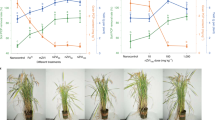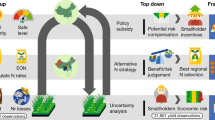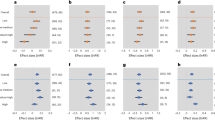Abstract
Rice production poses one of the most important dilemmas between climate regulation and food security. While fertilization often results in a higher yield, it is also accompanied by more greenhouse gas (GHG) emissions. For this dilemma, the final consideration usually depends on the trade-offs to mitigate on-going climate change while supporting a continuously growing global population. Here we conducted a 4-year field experiment to evaluate the capacity of iron oxide nanoparticles (FeONPs) at 6.3 kg ha−1 yr−1 as the basal fertilizer to close the gap of such trade-offs. Compared with urea fertilization, FeONPs can mitigate climate change by reducing 50% of methane (CH4) and nitrous oxide (N2O) emissions while supporting significant soil carbon sequestration by 7.4% in the fourth year. Moreover, through reductions in ammonia volatilization and the entrapment of nitrogen in nanoparticles, FeONPs improve the retention of soil nitrogen nutrients, leading to an increase in food production of up to 25%. Our results show that FeONPs effects became more and more prominent throughout a continuous 4-year application. Together, our study revealed FeONPs as a next-generation fertilizer with great potential to solve the dilemma of meeting food security demand while complying with climate regulation.
This is a preview of subscription content, access via your institution
Access options
Access Nature and 54 other Nature Portfolio journals
Get Nature+, our best-value online-access subscription
$29.99 / 30 days
cancel any time
Subscribe to this journal
Receive 12 digital issues and online access to articles
$119.00 per year
only $9.92 per issue
Buy this article
- Purchase on Springer Link
- Instant access to full article PDF
Prices may be subject to local taxes which are calculated during checkout



Similar content being viewed by others
Data availability
The authors declare that the data supporting the findings of this study are available within the paper and its Supplementary Information.
References
Xu, Z. et al. Impacts of irrigated agriculture on food–energy–water–CO2 nexus across metacoupled systems. Nat. Commun. 11, 5837 (2020).
Terrer, C. et al. A trade-off between plant and soil carbon storage under elevated CO2. Nature 591, 599–603 (2021).
FAOSTAT, Crops and livestock products, https://www.fao.org/faostat/en/#data/QCL (2022).
Li, S. et al. Enhancing rice production sustainability and resilience via reactivating small water bodies for irrigation and drainage. Nat. Commun. 14, 3794 (2023).
van Groenigen, K. J., van Kessel, C. & Hungate, B. A. Increased greenhouse-gas intensity of rice production under future atmospheric conditions. Nat. Clim. Change 3, 288–291 (2013).
Harmsen, M. et al. Uncertainty in non-CO2 greenhouse gas mitigation contributes to ambiguity in global climate policy feasibility. Nat. Commun. 14, 2949 (2023).
Carlson, K. M. et al. Greenhouse gas emissions intensity of global croplands. Nat. Clim. Change 7, 63–68 (2017).
Muehe, E. M., Wang, T., Kerl, C. F., Planer-Friedrich, B. & Fendorf, S. Rice production threatened by coupled stresses of climate and soil arsenic. Nat. Commun. 10, 4985 (2019).
Peng, S. et al. Rice yields decline with higher night temperature from global warming. Proc. Natl Acad. Sci. USA 101, 9971–9975 (2004).
Cai, S. et al. Optimal nitrogen rate strategy for sustainable rice production in China. Nature 615, 73–79 (2023).
Gilbertson, L. M. et al. Guiding the design space for nanotechnology to advance sustainable crop production. Nat. Nanotechnol. 15, 801–810 (2020).
Zhang, P. et al. Nanotechnology and artificial intelligence to enable sustainable and precision agriculture. Nat. Plants 7, 864–876 (2021).
Kah, M., Tufenkji, N. & White, J. C. Nano-enabled strategies to enhance crop nutrition and protection. Nat. Nanotechnol. 14, 532–540 (2019).
Xu, J. et al. Fe3O4 nanoparticles affect paddy soil microbial-driven carbon and nitrogen processes: roles of surface coating and soil types. Environ. Sci. Nano 9, 2440–2452 (2022).
An, Y. et al. Effect of bimetallic and polymer-coated Fe nanoparticles on biological denitrification. Bioresour. Technol. 101, 9825–9828 (2010).
Shankramma, K., Yallappa, S., Shivanna, M. B. & Manjanna, J. Fe2O3 magnetic nanoparticles to enhance S. lycopersicum (tomato) plant growth and their biomineralization. Appl. Nanosci. 6, 983–990 (2016).
Rui, M. et al. Iron oxide nanoparticles as a potential iron fertilizer for peanut (Arachis hypogaea). Front. Plant Sci. 7, 00815 (2016).
Rastogi, A. et al. Impact of metal and metal oxide nanoparticles on plant: a critical review. Front. Chem. 5, 78 (2017).
Di Iorio, E. et al. Environmental implications of interaction between humic substances and iron oxide nanoparticles: a review. Chemosphere 303, 135172 (2022).
Sun, X.-D. et al. Magnetite nanoparticle coating chemistry regulates root uptake pathways and iron chlorosis in plants. Proc. Natl Acad. Sci. USA 120, e2304306120 (2023).
Singh, D., Sillu, D., Kumar, A. & Agnihotri, S. Dual nanozyme characteristics of iron oxide nanoparticles alleviate salinity stress and promote the growth of an agroforestry tree, Eucalyptus tereticornis Sm. Environ. Sci. Nano 8, 1308–1325 (2021).
Guo, Y. et al. Air quality, nitrogen use efficiency and food security in China are improved by cost-effective agricultural nitrogen management. Nat. Food 1, 648–658 (2020).
Zhu, J. et al. Cradle-to-grave emissions from food loss and waste represent half of total greenhouse gas emissions from food systems. Nat. Food 4, 247–256 (2023).
Tawfik, M. M., Mohamed, M. H., Sadak, M. S. & Thalooth, A. T. Iron oxide nanoparticles effect on growth, physiological traits and nutritional contents of Moringa oleifera grown in saline environment. Bull. Natl Res. Cent. 45, 177 (2021).
Sheykhbaglou, R., Sedghi, M. & Fathi-Achachlouie, B. The effect of ferrous nano-oxide particles on physiological traits and nutritional compounds of soybean (Glycine max L.) seed. An. Acad. Bras. Cienc. 90, 485–494 (2018).
Wang, Y., Wang, H., He, J.-S. & Feng, X. Iron-mediated soil carbon response to water-table decline in an alpine wetland. Nat. Commun. 8, 15972 (2017).
Moore, O. W. et al. Long-term organic carbon preservation enhanced by iron and manganese. Nature 621, 312–317 (2023).
Hu, J. et al. Ferrous iron addition decreases methane emissions induced by rice straw in flooded paddy soils. ACS Earth Space Chem. 4, 843–853 (2020).
Gómez-Sagasti, M. T. et al. The impact of nanoscale zero-valent iron particles on soil microbial communities is soil dependent. J. Hazard. Mater. 364, 591–599 (2019).
He, S. et al. Different responses of soil microbial metabolic activity to silver and iron oxide nanoparticles. Chemosphere 147, 195–202 (2016).
Feng, Y. Z. et al. The role of metal nanoparticles in influencing arbuscular mycorrhizal fungi effects on plant growth. Environ. Sci. Tech. 47, 9496–9504 (2013).
Chen, J. & Sinsabaugh, R. L. Linking microbial functional gene abundance and soil extracellular enzyme activity: implications for soil carbon dynamics. Glob. Change Biol. 27, 1322–1325 (2021).
Chen, J., Luo, Y. & Sinsabaugh, R. L. Subsoil carbon loss. Nat. Geosci. 16, 284–285 (2023).
Cai, Y., Zheng, Y., Bodelier, P. L. E., Conrad, R. & Jia, Z. Conventional methanotrophs are responsible for atmospheric methane oxidation in paddy soils. Nat. Commun. 7, 11728 (2016).
Ding, B. et al. Nitrogen loss through denitrification, anammox and Feammox in a paddy soil. Sci. Total Environ. 773, 145601 (2021).
Yang, W. H., Weber, K. A. & Silver, W. L. Nitrogen loss from soil through anaerobic ammonium oxidation coupled to iron reduction. Nat. Geosci. 5, 538–541 (2012).
Chen, J., Luo, Y., Kätterer, T. & Olesen, J. E. Depth-dependent responses of soil organic carbon stock under annual and perennial cropping systems. Proc. Natl Acad. Sci. USA 119, e2203486119 (2022).
Freeman, C., Ostle, N. & Kang, H. An enzymic ‘latch’ on a global carbon store. Nature 409, 149–150 (2001).
Chen, J. et al. Differential responses of carbon-degrading enzyme activities to warming: implications for soil respiration. Glob. Change Biol. 24, 4816–4826 (2018).
Sheykhbaglou, R., Sedghi, M., Tajbakhsh Shishevan, M. & Seyed Sharifi, R. Effects of nano-iron oxide particles on agronomic traits of soybean. Not. Sci. Biol. 2, 112–113 (2010).
Islam, M. S. Sensing and uptake of nitrogen in rice plant: a molecular view. Rice Sci. 26, 343–355 (2019).
Rahman, A., Kang, S., McGinnis, S. & Vikesland, P. J. Life cycle impact assessment of iron oxide (Fe3O4/γ-Fe2O3) nanoparticle synthesis routes. ACS Sustain. Chem. Eng. 10, 3155–3165 (2022).
Lin, J. et al. The stabilizing mechanism of cadmium in contaminated soil using green synthesized iron oxide nanoparticles under long-term incubation. J. Hazard. Mater. 379, 120832 (2019).
Zhang, X. et al. Comprehensive analysis of the impacts of iron-based nanoparticles and ions on Anammox process. Biochem. Eng. J. 180, 108371 (2022).
Fang, Y. et al. Effect of foliar application of zinc, delenium, and iron fertilizers on nutrients concentration and yield of rice grain in China. J. Agric. Food Chem. 56, 2079–2084 (2008).
Audebert, A. & Fofana, M. Rice yield gap due to iron toxicity in West Africa. J. Agron. Crop Sci. 195, 66–76 (2009).
Zheng, X. et al. Environmental risk of microplastics after field aging: reduced rice yield without mitigating yield-scale ammonia volatilization from paddy soils. Environ. Pollut. 318, 120823 (2023).
Cantera, R. G., Zamarreño, A. M. & García-Mina, J. M. Characterization of commercial iron chelates and their behavior in an alkaline and calcareous soil. J. Agric. Food Chem. 50, 7609–7615 (2002).
Wintermans, J. F. G. M. & de Mots, A. Spectrophotometric characteristics of chlorophylls a and b and their phenophytins in ethanol. Biochim. Biophys. Acta 109, 448–453 (1965).
Liu, W. J. et al. Balanced stochastic versus deterministic assembly processes benefit diverse yet uneven ecosystem functions in representative agroecosystems. Environ. Microbiol. 23, 391–404 (2021).
Acknowledgements
This work was supported by the National Key Research and Development Program of China (no. 2021YFD1700803), the National Natural Science Foundation of China (42177297, 41771295, 42277332) and CAS Strategic Priority Research Program (XDA28010302). M.D.-B. acknowledges support from the Spanish Ministry of Science and Innovation for the I+D+i project PID2020-115813RA-I00 funded by MCIN/AEI/10.13039/501100011033. M.D-B. was also supported by a project of the Fondo Europeo de Desarrollo Regional (FEDER) and the Consejería de Transformación Económica, Industria, Conocimiento y Universidades of the Junta de Andalucía (FEDER Andalucía 2014-2020 Objetivo temático “01 - Refuerzo de la investigación, el desarrollo tecnológico y la innovación”) associated with the research project P20_00879 (ANDABIOMA).
Author information
Authors and Affiliations
Contributions
Y.F., L.Y. and S.H. developed the original ideas. Yingliang Yu, L.X. and S.H. provided the original data. S.H., Yingliang Yu and L.X. contributed to lab analyses. Yongjie Yu, S.H., M.D.-B. and Y.F. conducted statistical analyses. Yongjie Yu, Y.F., L.Z., M.D.-B. and S.H. wrote the first draft of the manuscript, and all authors contributed substantially to revisions.
Corresponding authors
Ethics declarations
Competing interests
The authors declare no competing interests.
Peer review
Peer review information
Nature Sustainability thanks Melanie Kah, Bruce Hungate and the other, anonymous, reviewer(s) for their contribution to the peer review of this work.
Additional information
Publisher’s note Springer Nature remains neutral with regard to jurisdictional claims in published maps and institutional affiliations.
Supplementary information
Supplementary Information
Supplementary Figs. 1–7 and Tables 1–5.
Rights and permissions
Springer Nature or its licensor (e.g. a society or other partner) holds exclusive rights to this article under a publishing agreement with the author(s) or other rightsholder(s); author self-archiving of the accepted manuscript version of this article is solely governed by the terms of such publishing agreement and applicable law.
About this article
Cite this article
Yu, Y., Feng, Y., Yu, Y. et al. Closing the gap between climate regulation and food security with nano iron oxides. Nat Sustain (2024). https://doi.org/10.1038/s41893-024-01334-6
Received:
Accepted:
Published:
DOI: https://doi.org/10.1038/s41893-024-01334-6



